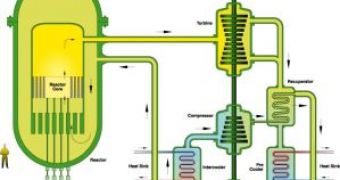The biggest problem of the current nuclear reactors is that they produce environmentally harmful long-lasting radioactive waste which takes hundreds of years to discharge off radioactivity.
But, in the future, a new generation of nuclear reactors will generate energy, while leaving virtually no long-lasting nuclear waste, as it was achieved in a research conducted by Wilfred van Rooijen, from Delft University of Technology.
Van Rooijen's investigation, made at the Reactor Institute Delft, focused on the nuclear fuel cycle and safety features of a Gas-cooled Fast Reactor (GFR), which belongs to the "fourth generation" nuclear reactor designs.
The concept of these reactors is a sustainable one: they are economical concerning the amount of nuclear fuel and are capable of producing a great deal of their own nuclear waste harmless.
But the technique to build such reactors is still not developed. The fourth generation GFR employs helium as a coolant at high temperatures (previous ones use water). The ultimate idea of GFR is to build a closed nuclear fuel cycle, in which only natural uranium is employed as a raw material and in which the waste of the process is made up only of nuclear fission products.
Uranium and heavier radioactive isotopes, such as plutonium and americum, are reintegrated in the circuit of the reactor and ultimately burned up (fissioned). In current reactors, these heavy radioactive isotopes determine the long-term radioactivity of the nuclear waste. A closed nuclear fuel cycle would permit with the maximum efficiency the use of raw materials, while at the same producing less and short-lived waste.
This research not only proved that a closed nuclear fuel cycle with a GFR is possible, but also that the GFR could utilize the waste materials of other light water reactors (LWR), which currently are discarded, contaminating the environment. The Gas-cooled Fast Reactor can therefore serve as an 'incinerator' of nuclear waste, reducing radioactive contamination and generating energy at the same time.
In order to increase the GFR's level of safety, specific elements have been projected to automatically shut down the reactor during incidents. These elements enable the reactor to resist incidents without damage to the nuclear fuel.

 14 DAY TRIAL //
14 DAY TRIAL //